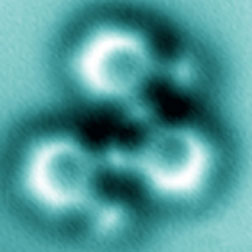- Number 390 |
- June 10, 2013
Atom by atom, bond by bond, a chemical reaction caught in the act

Atomic force microscopy reveals the
positions of individual atoms and bonds.
Graphene nanostructures can form the transistors, logic gates, and other elements of exquisitely tiny electronic devices, but to become practical they will have to be mass produced with atomic precision. Hit-or-miss, top-down techniques, such as unzipping carbon nanotubes, can’t do the job. When Felix Fischer of DOE’s Lawrence Berkeley National Laboratory set out to develop graphene nanostructures from the bottom up, using controlled chemical reactions, the outcomes of the reaction were unexpected, but the visual evidence was even more so.
Fischer, a staff scientist in Berkeley Lab’s Materials Sciences Division (MSD) and a professor of chemistry at the University of California at Berkeley, worked with his colleague Michael Crommie of MSD, a UC Berkeley professor of physics. To see what was happening at the single-atom level they used a uniquely sensitive noncontact atomic force microscope (nc-AFM) to image the starting molecule – composed of three benzene rings linked by carbon atoms – placed on a silver surface. Heating the substrate induced reactions, and the microscope recorded the products.
“We weren’t thinking about making beautiful images; the reactions themselves were the goal,” says Fischer. What they got, however, were spectacular images of individual carbon atoms and the bonds between them. “Nobody has ever taken direct, single-bond-resolved images of individual molecules, right before and immediately after a complex organic reaction.”
An nc-AFM probes the surface with a very sharp tip, in this case a single oxygen atom in a carbon monoxide molecule adsorbed on the tip of the stylus. The stylus is mechanically deflected by electronic forces close to the sample as the tip moves over it.
“Moving this ‘atomic finger’ back and forth over the silver surface is like reading Braille, as if we were feeling the small atomic-scale bumps made by the atoms,” says Fischer.
The nc-AFM’s moving finger feels not only individual atoms but the forces of the bonds, even distinguishing between single, double, and triple bonds.
The resulting images bear a startling resemblance to diagrams from textbooks used to teach chemistry – except here no imagination is required.[Paul Preuss, 510.486.6249,
paul_preuss@lbl.gov]
